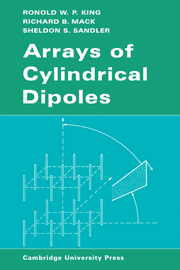Book contents
- Frontmatter
- Contents
- Preface
- CHAPTER 1 INTRODUCTION
- CHAPTER 2 AN APPROXIMATE ANALYSIS OF THE CYLINDRICAL ANTENNA
- CHAPTER 3 THE TWO-ELEMENT ARRAY
- CHAPTER 4 THE CIRCULAR ARRAY
- CHAPTER 5 THE CIRCUIT AND RADIATING PROPERTIES OF CURTAIN ARRAYS
- CHAPTER 6 ARRAYS WITH UNEQUAL ELEMENTS; PARASITIC AND LOG-PERIODIC ANTENNAS
- CHAPTER 7 PLANAR AND THREE-DIMENSIONAL ARRAYS
- CHAPTER 8 TECHNIQUES AND THEORY OF MEASUREMENT
- Appendix I Tables of ΨdR, T(m) or T′(m) and self- and mutual admittances for single elements and circular arrays
- Appendix II Summary of the two-term theory for applications
- Appendix III Summary of formulas for the curtain array
- Appendix IV Tables of admittance and impedance for curtain arrays
- Appendix V Programme for Yagi-Uda array
- References
- List of symbols
- Index
CHAPTER 8 - TECHNIQUES AND THEORY OF MEASUREMENT
Published online by Cambridge University Press: 24 May 2010
- Frontmatter
- Contents
- Preface
- CHAPTER 1 INTRODUCTION
- CHAPTER 2 AN APPROXIMATE ANALYSIS OF THE CYLINDRICAL ANTENNA
- CHAPTER 3 THE TWO-ELEMENT ARRAY
- CHAPTER 4 THE CIRCULAR ARRAY
- CHAPTER 5 THE CIRCUIT AND RADIATING PROPERTIES OF CURTAIN ARRAYS
- CHAPTER 6 ARRAYS WITH UNEQUAL ELEMENTS; PARASITIC AND LOG-PERIODIC ANTENNAS
- CHAPTER 7 PLANAR AND THREE-DIMENSIONAL ARRAYS
- CHAPTER 8 TECHNIQUES AND THEORY OF MEASUREMENT
- Appendix I Tables of ΨdR, T(m) or T′(m) and self- and mutual admittances for single elements and circular arrays
- Appendix II Summary of the two-term theory for applications
- Appendix III Summary of formulas for the curtain array
- Appendix IV Tables of admittance and impedance for curtain arrays
- Appendix V Programme for Yagi-Uda array
- References
- List of symbols
- Index
Summary
The preceding chapters are devoted to the development of a theory to predict the characteristics of arrays of physically real dipoles and monopoles. This chapter is concerned with the experimental determination of these characteristics and with the correlation of measured and theoretical results. In practice, the mathematical intricacies of theoretical formulas can be largely avoided by means of a computer programme to which a user need only supply the parameters of a particular array to obtain radiation patterns, driving-point admittances or impedances, and other characteristics. When programmed in this manner, the computer becomes a simulator which can be substituted for the repeated testing and adjusting commonly required in designing an array. However, the value of such a simulator rests entirely on how well predictions agree with observation when the final model is assembled. Comparisons in the preceding chapters between measured and computed results indicate that the theory is capable of describing an actual experimental model with acceptable accuracy. However, in applying the theoretical results to different experimental systems, account must be taken of certain considerations and precautions if such agreement is to be obtained. It is these considerations which are of primary concern in the present chapter.
The required measuring techniques have been discussed in general in several books; the purpose here is to examine difficulties and procedures which apply particularly to arrays of dipoles and monopoles. Although the discussions are not restricted to any particular range of frequencies, most of the procedures have been used in the 100–1200 MHz range.
- Type
- Chapter
- Information
- Arrays of Cylindrical Dipoles , pp. 323 - 392Publisher: Cambridge University PressPrint publication year: 1968



